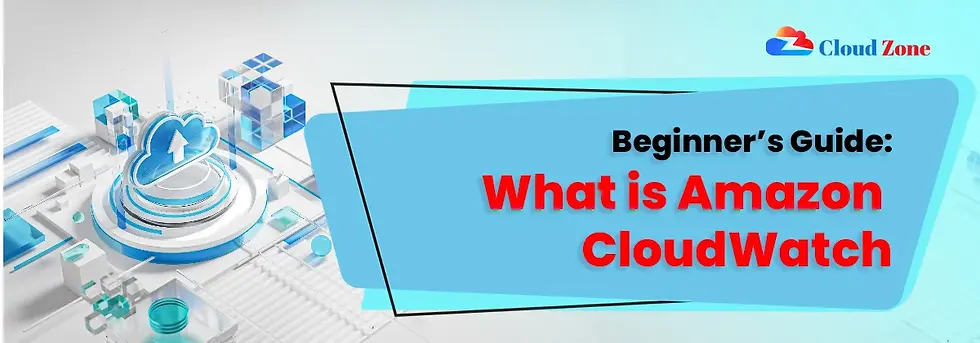AWS Cloud Watch Pricing: Optimize Monitoring Without Overspending
- jobs3074
- Sep 23
- 4 min read
Introduction
Amazon CloudWatch is a powerful monitoring and observability service that helps businesses track AWS resources, applications, and infrastructure in real-time. With CloudWatch, you can monitor metrics, analyze logs, set alarms, and respond to system changes automatically. aws api gateway and cloudwatch metrics diagram However, CloudWatch pricing can become complex if not managed carefully. Understanding its pricing model is essential to optimize costs while maintaining effective monitoring.

What is Amazon Cloud Watch?
Cloud Watch allows you to:
Monitor AWS resources such as EC2, RDS, Lambda, API Gateway, and S3
Collect and track metrics in real-time
Visualize metrics on dashboards
Analyze logs for troubleshooting and insights
Set alarms to automatically respond to changes in your system
By integrating Cloud Watch with AWS services, organizations can maintain operational health and improve reliability.
Components of Cloud Watch Pricing
Cloud Watch pricing is based on multiple components:
1. Metrics
Basic Monitoring: Default metrics for AWS services like EC2 (1-minute intervals) are often free.
Detailed Monitoring: Additional metrics with 1-minute granularity incur a cost per metric per month.
Custom Metrics: Any custom metric you create is charged based on usage and frequency.
2. Dashboards
Cloud Watch Dashboards allow you to visualize metrics across multiple services.
Pricing is based on the number of dashboards and widgets per dashboard.
3. Alarms
Alarms notify you when metrics cross thresholds.
Charged per alarm per month.
High-resolution alarms (1-second intervals) are more expensive than standard 1-minute alarms.
4. Logs
Cloud Watch Logs pricing depends on:
Data Ingestion: Cost per GB of log data ingested.
Data Storage: Cost per GB stored per month.
Retention: Long-term retention of logs increases storage costs.
5. Events and Insights
Cloud Watch Events (Event Bridge): Charges based on the number of events.
Cloud Watch Logs Insights: Charged per GB scanned per query for advanced log analytics.
Cloud Watch Pricing Example
Here’s a simplified example:
Component | Cost Example | Notes |
EC2 Default Metrics | Free | 5-minute intervals |
Custom Metrics | $0.30 per metric/month | Additional metrics beyond default |
Dashboards | $3 per dashboard/month | Standard widgets included |
Logs Ingestion | $0.50 per GB | Charges for incoming log data |
Logs Storage | $0.03 per GB/month | Retained log storage |
Alarms | $0.10 per alarm/month | Standard resolution |
Prices may vary by AWS region and are subject to change.
Best Practices to Optimize Cloud Watch Costs
1. Enable Detailed Metrics Selectively
Use detailed monitoring only for critical resources; basic monitoring is sufficient for non-critical workloads.
2. Set Log Retention Policies
Automatically expire old logs to save storage costs. Define retention policies based on compliance and operational needs.
3. Aggregate Metrics
Use metric math to combine multiple metrics into one, reducing the number of custom metrics and associated costs.
4. Use High-Resolution Alarms Judiciously
Reserve 1-second resolution alarms for mission-critical applications only. For most scenarios, 1-minute alarms are sufficient.
5. Filter Logs Before Ingestion
Avoid ingesting unnecessary log data. Use filters to capture only meaningful information.
6. Optimize Dashboards
Combine multiple metrics in one widget where possible to reduce the number of dashboards.
Benefits of Optimized Cloud Watch Usage
Cost Efficiency: Reduce unnecessary expenses by following best practices.
Improved Visibility: Monitor key metrics without overspending on minor or redundant data.
Proactive Management: Detects issues early with alarms and logs.
Operational Efficiency: Focus on critical resources while keeping monitoring costs under control.
Conclusion
Amazon Cloud Watch is essential for monitoring AWS resources and applications, but without proper planning, costs can escalate. By understanding Cloud Watch pricing components—metrics, dashboards, alarms, logs, and events—and following best practices such as selective metrics, log retention, and metric aggregation, you can optimize monitoring costs while maintaining operational excellence.
Proper Cloud Watch management ensures that your applications remain highly available, reliable, and cost-efficient, allowing businesses to focus on growth without worrying about excessive monitoring charges.
Q1: What is AWS Cloud Watch and why is it important?
A:
Cloud Watch monitors AWS resources like EC2, Lambda, RDS, and API Gateway.
Collects metrics, logs, and events for real-time visibility.
Enables automated alarms for performance and availability issues.
Helps in cost optimization by tracking resource usage.
Provides dashboards for actionable insights and operational monitoring.
Q2: What are the main pricing components of Cloud Watch?
A:
Metrics – Basic, detailed, and custom metrics.
Alarms – Standard and high-resolution alarms for thresholds.
Logs – Ingestion, storage, and retention costs.
Dashboards – Number of dashboards and widgets.
Events/Insights – Event Bridge events and Logs Insights queries.
Q3: How can Cloud Watch costs be optimized?
A:
Enable detailed metrics only for critical resources.
Set log retention policies to expire old logs.
Aggregate multiple metrics to reduce custom metric usage.
Use high-resolution alarms selectively.
Filter logs before ingestion to avoid unnecessary data costs.
Q4: What are the benefits of using Cloud Watch efficiently?
A:
Reduced operational costs by eliminating unnecessary monitoring.
Improved visibility into resource performance and health.
Faster detection and troubleshooting of errors.
Optimized dashboards for quick insights.
Proactive alerting to prevent downtime or failures.
Q5: Can Cloud Watch be integrated with other AWS services for better monitoring?
A:
Integrated with AWS API Gateway to monitor API usage and latency.
Works with AWS Lambda to track invocation metrics.
Supports SNS for alarm notifications.
Connects with Cloud Trail for audit and security monitoring.
Used alongside AWS X-Ray for detailed application performance analysis.



Comments